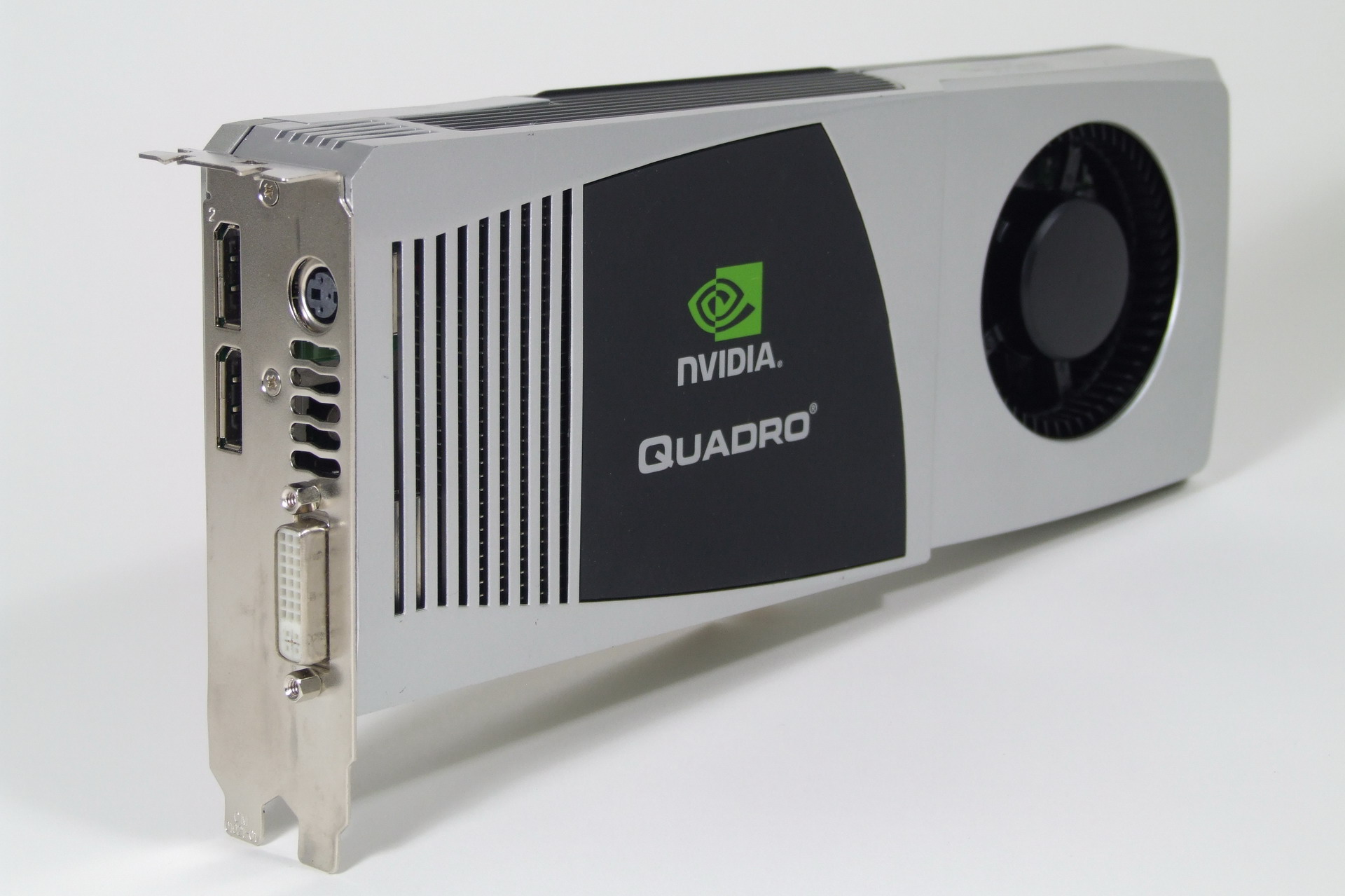Nvidia Quadro FX 4800: Workstation Graphics At Its Finest?
Introduction

Nvidia's gaming graphics cards have been slowly moving away from the old-faithful G80 chip. Now, in fact, Nvidia's latest workstation offerings are outfitted with derivatives of Nvidia's GT200 GPUs, which many have come to know through their inclusion in the cheaper mainstream GeForce GTX 260 and 280 cards.
The first entrants in this product line are the Quadro FX 5800 at the extreme high-end, with its 4 GB frame buffer, and the more "reasonably priced" Quadro FX 4800, with its 1.5 GB of graphics memory. That latter board found its way into our test labs, so that we could put it through its paces. In a few weeks, we expect to get our hands on other models in this series as well.
The FX 4800 commands a price premium of over $300 compared to the equivalent FirePro V8700 from AMD's ATI division, which online resellers retail for about $1,250. Can buyers expect a boost in features and performance for this extra outlay? First, let's take a look at the comparable cards and their speeds and feeds from both companies in the tables that follow, then we'll get around to answering this burning question.
| Workstation Graphics Cards and their Mainstream Equivalents | ||||||
|---|---|---|---|---|---|---|
| Workstation Model | Derivative GPU | Fab | Mainstream-Equivalent | Graphics RAM | 3-Pin Stereo | DisplayPort |
| Nvidia Quadro FX 5600 | G80 | 90 nm | GeForce 8800 | 1,536 MB GDDR3 | yes | no |
| Nvidia Quadro FX 4800 | GT200 | 65 nm | GeForce GTX 260 (280) | 1,536 MB GDDR3 | yes | yes |
| Nvidia Quadro FX 4600 | G80 | 90 nm | GeForce 8800 | 768 MB GDDR3 | yes | no |
| Nvidia Quadro FX 1700 | G84 | 80 nm | GeForce 8600 | 512 MB DDR2 | yes | no |
| ATI FirePro V8700 | RV770 | 55 nm | Radeon HD 4870 | 1,024 MB GDDR5 | yes | yes |
| ATI FireGL V7700 | RV670 | 55 nm | Radeon HD 3850 | 512 MB GDDR4 | yes | yes |
| ATI FireGL V5600 | RV630 | 65 nm | Radeon HD 2600 XT | 512 MB GDDR4 | no | no |
| ATI FireGL V3600 | RV630 | 65 nm | Radeon HD 2600 Pro | 256 MB DDR2 | no | no |
| Workstation Model | Memory (RAM) Bandwidth | DirectX | OpenGL | Shader Model | Core Clock | Memory Clock | Pixel & Vertex Processing |
| Nvidia Quadro FX 5600 | 76.8 GB/s | 10 | 2.1 | 4.0 | 600 MHz | 800 MHz | 112 SPUs |
| Nvidia Quadro FX 4800 | 76.8 GB/s | 10 | 3.0 | 4.0 | 600 MHz | 800 MHz | 192 SPUs |
| Nvidia Quadro FX 4600 | 67.2 GB/s | 10 | 2.1 | 4.0 | 500 MHz | 700 MHz | 112 SPUs |
| Nvidia Quadro FX 1700 | 12.8 GB/s | 10 | 2.1 | 4.0 | 460 MHz | 400 MHz | 32 SPUs |
| ATI FirePro V8700 | 115.2 GB/s | 10.1 | 2.1 | 4.0 | 750 MHz | 900 MHz | 800 SPUs |
| ATI FireGL V7700 | 72.0 GB/s | 10.1 | 2.1 | 4.0 | 775 MHz | 1,125 MHz | 320 SPUs |
| ATI FireGL V5600 | 35.1 GB/s | 10 | 2.1 | 4.0 | 800 MHz | 1,100 MHz | 120 SPUs |
| ATI FireGL V3600 | 15.8 GB/s | 10 | 2.1 | 4.0 | 600 MHz | 500 MHz | 120 SPUs |
Stay On the Cutting Edge: Get the Tom's Hardware Newsletter
Get Tom's Hardware's best news and in-depth reviews, straight to your inbox.
-
why do i feel like when everyone compares workstation cards to gaming ones they get it wrong. a 4800 Fx will performs 99% like a 260GTX and if you softmod it to a Quadro than you have the same effect the other way around. really you are paying for driver support. i much rather just pay for the card.Reply
-
ankolistoflower They really mean it when they say great support. I once got a custom driver made specificly for my system overnight for a glitch I had. It saved me from loosing a client and a few thousand dollars for that one specific gig...Reply -
cangelini bob49574why do i feel like when everyone compares workstation cards to gaming ones they get it wrong. a 4800 Fx will performs 99% like a 260GTX and if you softmod it to a Quadro than you have the same effect the other way around. really you are paying for driver support. i much rather just pay for the card.Reply
I think the comparison to the gaming card came from readers in past workstation card stories requesting such comparisons. -
ph3412b07 Great article, I appreciate the benches comparing the GTX 280 on workstation apps. I'll spend my money on gaming cards and leave it to corporations to purchase workstations...Reply -
ohim cangeliniI think the comparison to the gaming card came from readers in past workstation card stories requesting such comparisons.this is challanging the consumers intelect with all things on the table ... actulay is the same GPU chip but performs so differently because of few modifications ... wonder how much this thing will keep up from nvidia and amd ... makeing their customers stupid so obvious ... i mean it is the same fukin engine at heart why sell it so overpriced ?Reply -
Looking at the results, I cannot understand how you can wholeheartedly recommend FX 4800 over cheaper FirePro V8700. Quadro benchmark results do not seem "convincing" to me since differences are quite small in most cases. The recommendation has to be based on type of work/application someone is using.Reply
-
armistitiu I'm getting tired of NVIDIA's crap: "....but our cards have CUDA support". Enough marketing! I think someone who's willing to buy a card because they want to program on the GPU MUST know that both vendors have a SDK for stream programming and it's actually the SAME thing. I've tried them both (FireStream and CUDA) and there are very little differences between them. If they wanna brag about 3rd party apps...well how many are they? 2? 3? Just wait until OpenCL (sdk and cl) is finally released and maybe then we'll see more applications in this GPGPU area and maybe they'll stop with this "oh but we have CUDA" thing.Reply -
fayskittles I would like to see them use riva tuner and to tell the drivers it is not a geforce and see what kind of bench marking they get then. Or the other way around. Turn the workstation card into a gaming card. How about throwing a game on a workstaion card. See how it handles it.Reply
